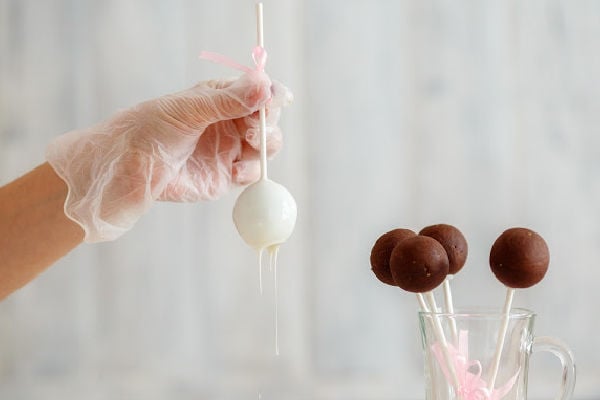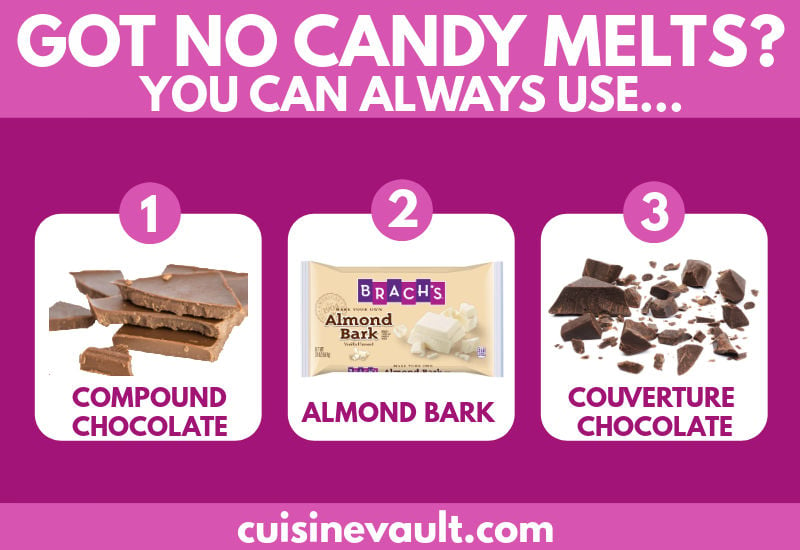Candy melts are a type of sweet confectionery that come in a variety of colors and flavors. They can be melted and used to dip cake pops, decorate cupcakes and cakes, coat pretzels, mold candy, and much more. If a recipe calls for piping, decorating, or drizzling, then candy melts are a fun, easy to prepare product.
If candy melts aren't available at your local store or you'd prefer not to use this product then you're going to need an alternative. We've put together a list of some excellent candy melt substitutes so that you can finish any recipe without the original ingredient.
Table of Contents
What can I use to replace candy melts?
If you need a candy melt substitute, for most applications compound chocolate or almond bark will work best. To take any sweet treat to the next level, consider tempering a good quality couverture chocolate. In a pinch, you could try whipped frosting, melted marshmallows, or kinako.
1. Compound chocolate
Compound chocolate is a low-cost alternative to real chocolate and is made from a combination of ingredients like cocoa, sweeteners, and vegetable oil. If you're making candy, this type of chocolate can easily be melted down and used for dipping, molding, or any other job that calls for candy melts. Although some people like to add a teaspoon or two of vegetable oil or Crisco shortening to help with the consistency, it isn't necessary.
You can use compound chocolate straight from the packet and it is an easy product to work with in the kitchen. Follow the packet instructions, but in general, microwaving the chocolate in a bowl for one minute at 50% power is a good start. If it isn’t ready, continue heating in 15-second increments.

Compound chocolate is excellent for dipping.
Tip: if the chocolate is almost melted when you remove it from the microwave then don't continue heating. The chocolate will continue to melt after you remove it from the microwave.
Although milk or dark chocolate are also suitable options, we recommend white chocolate if you want to add color to your creations. Once it's melted, add oil-based colors such as the range produced by Americolor.
2. Almond bark
Almond bark is another handy alternative to candy melts. It is a type of confection that includes fats, flavoring, and color additives to create a chocolate-like product. You can buy almond bark in blocks or discs in baking supply stores or the baking aisle in some supermarkets. For those looking for keto alternatives, there are products such as Keto Bark that are available online.
If you're looking for a low-cost confection for dipping and decorating your sweet treats, then almond bark is an excellent option. Unlike some chocolate that can be temperamental when heated, almond bark is simple to heat and apply. You don't have to worry as much about it seizing, a frustrating problem when dealing with regular chocolate.
Almond bark is white which makes it good for adding color. But keep in mind if you add liquid to it when melted, it will clump into an unusable mess. Instead, add a powder, paste, or oil-based food coloring for the best results.
3. Couverture chocolate
Couverture is the best type of real chocolate for melting and dipping due to its high ratio of cocoa butter to cocoa. Its taste is superior to any other option on this list including candy melts. Use this option if you are looking to impress guests or you're simply the type of person that enjoys eating real chocolate that's high quality. If you're going to use this type of chocolate, then tempering is essential during the melting process. Doing this creates a delicious looking shiny chocolate that has an unbeatable crunchy texture when you bite through it.
For an impressive thin coating, you can combine the chocolate in equal parts with melted sweet butter. Use this mix to glaze cakes, cookies, and tortes. If the mixture gets too thick, reheat it gently and continue.
What is tempering?
Tempering is the process of heating chocolate in a certain way so that it has a shiny, crunchy surface. Even if the chocolate gets exposed to air, it won't develop “bloom”. This is a white coating that other chocolate develops over time. Couverture is an excellent choice for this purpose; if you don't have any, then choose good quality chocolate that is high in cocoa solids.
How to temper chocolate
Using a bain-marie, heat white chocolate to 110°F or 115°F for milk chocolate. Once the temperature is reached, remove the bowl from the heat and place in an ice bath until it reduces to 82°F (28°C). After cooling, return the bowl to the bain-marie and continue to gently reheat back up to 88°F (31°C). Your chocolate should now be tempered.
You can read more about the tempering process and loads in our handy chocolate guide.

4. Frosting
In a pinch, you can try frosting in place of candy melts for some recipes. Although it is best for icing cakes and cupcakes, you could also use it for coating cake pops (aka cake balls). You won't be able to dip them into the icing like you would with candy melts, so instead, use a palette knife to carefully decorate your baked goods.
Making frosting is easy and it is economical. Also, you can color it with any type of food dye without having to worry about the mixture seizing.
5. Soybeans and sugar
Kinako powder is roasted soybean powder that sometimes has sugar mixed into it. It may not sound like the best combination for your sweet desserts, but if you are open to new flavors then this may well be worth trying. Like with frosting, you won't be able to use this option for dipping, but it makes an excellent cupcake topping and can also be used for molding into shapes. The texture can be adjusted by adjusting the amount of kinako.
6. Marshmallows
Another candy melt substitute you could consider is melted marshmallows. Once heated, use it to dip cupcakes and cake pops. Marshmallow fluff will also work as an alternative.
Summing up
Candy melts, made by Wilton, are a handy ingredient to have in the kitchen. They are easy to use and come in a wide variety of colors - perfect for Halloween candy, dessert recipes, baked goods, and Valentine candy. If you need to replace candy melts then your best options are compound chocolate or almond bark. If you don't mind the challenge, consider tempering couverture chocolate for a better tasting, shinier coating. Other options like frosting, kinako powder, or melted marshmallows will also work in some recipes but their use will be limited and the taste will be different.
What are you looking to make with a candy melt substitute? Please let us know in the comments below.

Leave a Reply